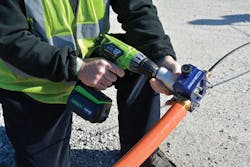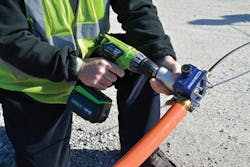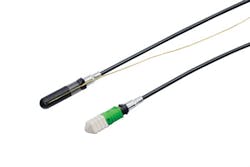Once-alternative cable installation methods are becoming more common
By Patrick McLaughlin
The term “cable pull” evokes a true-to-life image, even for people unfamiliar with the structured cabling industry, of the labor involved in the installation of layer-one infrastructure. Bundles of cables are pulled, often by human hands and sometimes by machines, from one point to another in a building, across a campus, or down a street. The tension or force with which the cables are pulled has the potential to adversely affect the cables’ performance, installers have been taught, so it is an act to be undertake with care rather than abandon. However, anyone even moderately experienced in cable pulls undoubtedly has a few stories about a difficult pull that required some brute strength and assuredly involved pulling tensions that exceeded standards-based limits.
For years the FutureFlex Air-Blown Fiber (ABF) system from Sumitomo Electric Lightwave (www.futureflex.com) stood almost alone as an alternative to the traditional cable pull for installing a layer-one infrastructure. A FutureFlex ABF installation is the opposite of a cable pull in both ways-it’s not a cable but rather a fiber or group of fibers being installed, and the fibers are not pulled but rather blown or pushed to their destination.
Value proposition
The company explains the system this way: “At the heart of the FutureFlex Air-Blown Fiber System is an infrastructure of tube cable in a wide variety of outdoor and indoor riser- and plenum-rated options that forms the intrabuilding and in-building LAN topology or fiber pathway. The non-PVC tube cable contains up to 19 smaller empty tubes and can be direct buried in the outside plant to replace both traditional conduit and innerduct. The tube cable, however, is also flexible enough to be placed in an existing conduit pathway … It’s a fiber pathway that is installed once and reused over and over again. It’s a pathway infrastructure system that facilitates a splice-free, continuous fiber run.”
Sumitomo Electric Lightwave has long extolled the value proposition for an air-blown fiber system versus traditional pulled cable. An article we published in 2014 offered an independent-party confirmation of much of what Sumitomo has said for years. The article titled “A comparison of conventional fiber and blown cable,” (August 2014) was co-authored by Julie Paulson, a consultant with Practical Business and Philip D. Klingensmith, owner of Compass Consulting. The duo authored the article after conducting analysis focused on the economics of both installation types in a three-phase, five-mile outside plant installation.
After explaining how their analysis showed a greater-than-two-thirds cost savings when air-blown fiber is used, Paulson and Klingensmith state, “Blown cable costs less, and saves time, resulting in being the most-efficient choice.”
Real-world deployments that yield the types of cost savings described in the Paulson/Klingensmith article continue to accumulate blown-fiber users. The FutureFlex website includes success stories about users across a number of industries, including healthcare, hospitality, entertainment, education and others.
More alternatives
As 2015 turns to 2016, the FutureFlex no longer stands alone as a prominent alternative system and method to the traditional cable pull. In 2013 the eABF Enterprise Air-Jetted Fiber system came to market through the collaboration of AFL (www.aflglobal.com), which provides the system’s optical media, and Dura-Line (www.duraline.com), which provides the system’s pathway. When announcing the system, the companies said its core is “the cable and duct. One of the unique features of the cable is the … low-friction high-drag jacketing system that enables the cable to move along the duct at a faster rate of speed … The cable can be deployed within the cable raceway and management system once exiting the pathway without the need for additional furcation tubing. The cable geometry makes it ideal for installation in the Dura-Line 8.5x6-mm Enterprise FuturePath system.”
The eABF system initially accommodated up to 48 fibers, but in early 2015 AFL announced it can accommodate a 72-fiber cable that uses the company’s Spider Web Ribbon design and construction. “The ultra-small, ribbon-like cable can be quickly ribbonized for mass termination,” AFL said in a February announcement. “Fifty percent smaller than traditional flat ribbon cables, the 72-fiber cable is fully optimized for jetting into the Dura-Line 8.5/6-mm FuturePath MicroDuct pathway system.”
AFL product manager Stephen Martin commented, “With this combination of high-density cable and multi-cell pathway, network designers can select eABF components that provide flexibility for network circuit expansion on an as-needed basis. For example, a 24-way FuturePath system with the 72-fiber eABF SWR cable allows for incremental network growth of up to 1,728 optical fibers.”
In addition to providing the pathway for the eABF system, Dura-Line also provides the jetting machinery. Its UltimaZ V-20 and MicroJet PRM-196 are “ideal for pushing and jetting Enterprise MicroCables into standard or riser-rated single, or bundled FuturePath MicroDuct products,” the company says. It adds that its Plummet MiniJet suits “enterprise applications where larger micro or conventional optical fiber cables are being placed in ducts up to 42mm outside diameter, or FuturePath and single MicroDuct sections, such as feeder routes between structures in a campus or mutli-dwelling unit environment.”
In June Greenlee Communications and Sherman + Reilly, both Textron companies, introduced the UltimaZ Point-to-Point (P2P) Hybrid Fiber Drop Installation system, which the companies describe as “a user-friendly solution used to install short sections of cables from 50 feet to 1,200 feet with ease.”
When announcing the system, Greenlee said it “offers a stress-free CableJetting method that reduces the rate of damaged fiber-optic cable. Installation speeds of up to 600 feet per minute allow a six-times-faster rate compared to hand pulling. This installation device comes with a handheld or stand-mounted hybrid design that uses this pushing or jetting method, that combines a low-strain pushing force with a high-speed air stream along the microcable surface for round or flat drop cables with outer diameters of 3 to 10.5 mm. Drops may be pushed via compressed air, or bottled air may be introduced into the system for longer distances. Although designed for drops, some cable duct combinations may yield installation lengths near 3,000 feet.”
The three-pound installation system “reduces fatigue and injuries compared to hand pulling,” Greenlee said. “The cable installs directly from the reel, so no pull lines are used. The UltimaZ P2P can be used to install both round and flat cables, and is also compatible with microducts from 10-mm to 18-mm in diameter. The use of a special insert will adapt to OSP ducts from one-half-inch, three-fourths-inch, one inch, and one-and-one-fourths-inches” in inside diameter.
Pushing fiber
Also introduced in 2013-the same year as the AFL/DuraLine eABF system-was Clearfield’s FieldShield, which the company characterizes as “a strong and flexible platform that offers a space-saving footprint across all deployment environments to support aerial, direct-bury and data center last-mile optical fiber needs … FieldShield components can be used standalone, with existing conduit equipment, or in collaboration with newer, less-disruptive technologies to bring fiber wherever and whenever it is needed.”
The system’s components include microduct, pushable fiber, pushable fiber connectors, and FieldShield Assist, a handheld, drill-powered tool with similar functions as Greenlee’s UltimaZ P2P, which Clearfield recommends for installs longer than 100 feet.
Citing already-installed systems at the time FieldShield was publicly announced, Clearfield explained that reducing the duct size to 10mm and smaller “opens unlimited opportunities to deploying and protecting fiber within the network. Installed as an empty microduct or preloaded with fiber, FieldShield Microduct can easily be placed through existing conduit, buried in the ground or deployed in an aerial environment.” The company cited the microduct’s smooth inner wall and slip lining as providing “minimal resistance, allowing FieldShield Pushable Optical Fiber Assemblies to be easily pushed or pulled through the transport duct.”
In 2014 Clearfield added the Aerial 500 Microduct to its FieldShield line. The crush- and tension-resistant microduct “integrates into pole-mounted distribution terminals, providing an aerial pole-to-pole distribution and ‘last mile’ drop to the customer premise,” at distances up to 500 feet, the company said. Johnny Hill, Clearfield’s chief operating officer, added, “Bringing fiber to environments that weren’t previously possible is our goal at Clearfield. Long-haul microduct means that utility poles can be 500 feet apart, reducing the number of poles required by more than 40 percent. Customers report that long-haul aerial microduct reduces their cost of deployment by nearly 50 percent.”
The company has made a number of other additions to the FieldShield line, including a pushable MPO connector.
By any measure the cable pull is still a staple of the industry and a process carried out, many times over, each day. But increasingly, physical-layer connections within networks are being accomplished by means other than pulling cable.
Patrick McLaughlin is our chief editor.


